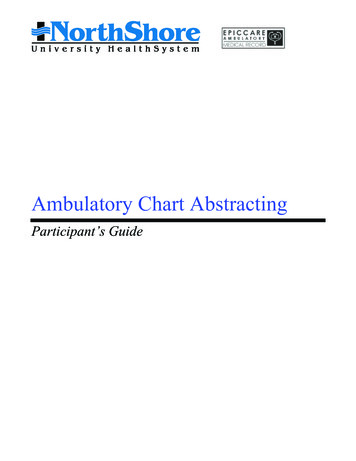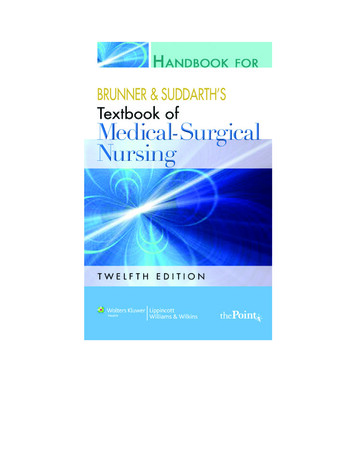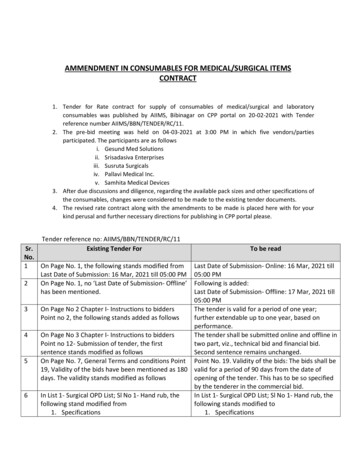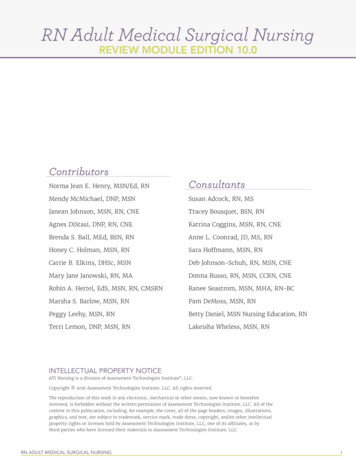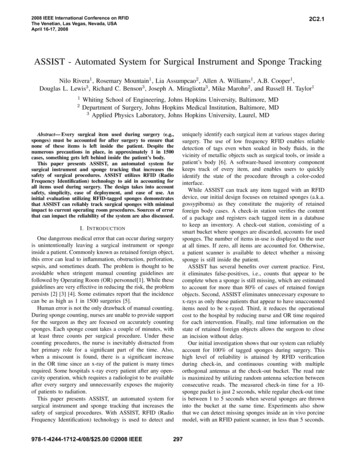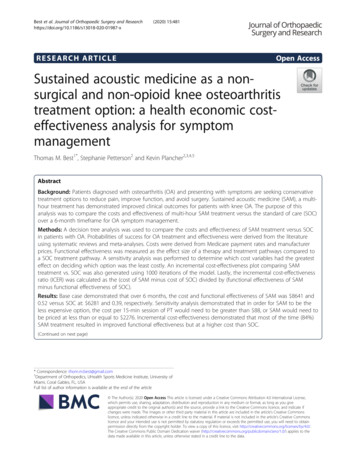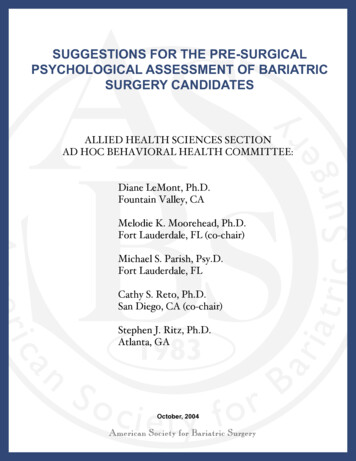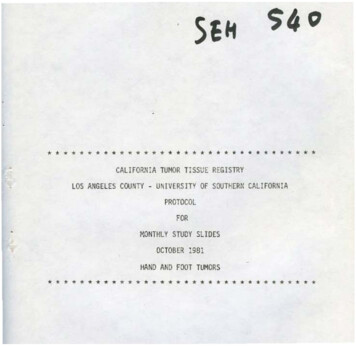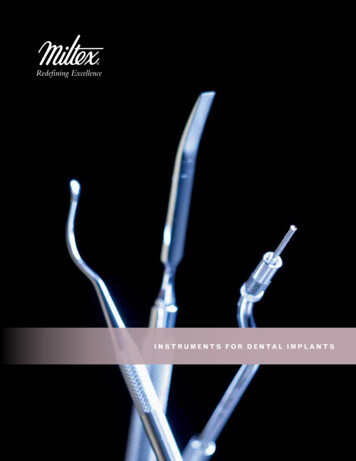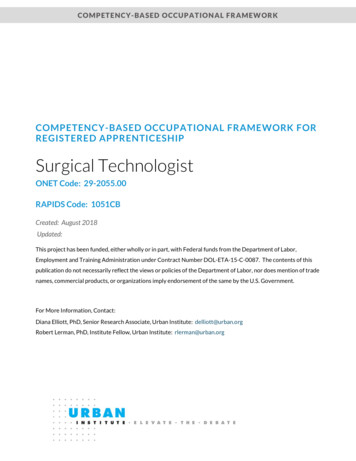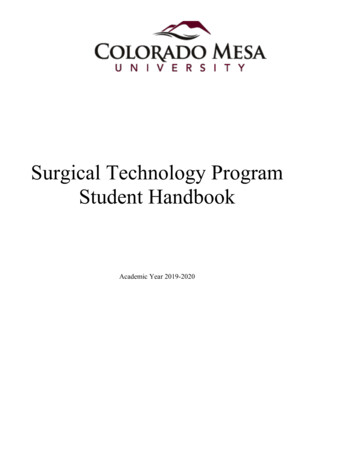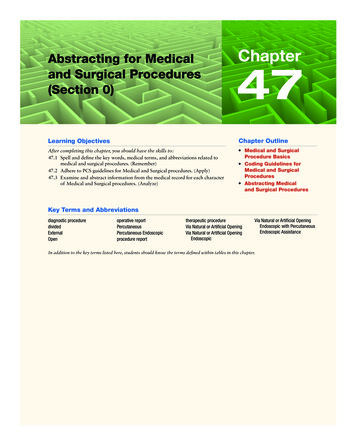
Transcription
Abstracting for Medicaland Surgical Procedures(Section 0)Chapter47Learning ObjectivesChapter OutlineAfter completing this chapter, you should have the skills to:47.1 Spell and define the key words, medical terms, and abbreviations related tomedical and surgical procedures. (Remember)47.2 Adhere to PCS guidelines for Medical and Surgical procedures. (Apply)47.3 Examine and abstract information from the medical record for each characterof Medical and Surgical procedures. (Analyze) Medical and Surgical Procedure Basics Coding Guidelines forMedical and SurgicalProcedures Abstracting Medicaland Surgical ProceduresKey Terms and Abbreviationsdiagnostic proceduredividedExternalOpenoperative reportPercutaneousPercutaneous Endoscopicprocedure reporttherapeutic procedureVia Natural or Artificial OpeningVia Natural or Artificial OpeningEndoscopicVia Natural or Artificial OpeningEndoscopic with PercutaneousEndoscopic AssistanceIn addition to the key terms listed here, students should know the terms defined within tables in this chapter.M47 PAPA8801 02 SE C47.indd 97118/10/2018 19:38
972SECTION FOUR ICD-10-PCS Procedure CodingINTRODUCTIONWhen you visit a new city, you might first go to the visitor’sinformation center to gather some general information aboutthe area before exploring individual attractions. Your introduction to the PCS Medical and Surgical Section is presented intwo chapters. In this chapter, you become familiar with howthe largest section in the PCS manual is structured and howto abstract information for each character of the code. Mostimportantly, you learn many of the definitions that are thecornerstone of ICD-10-PCS and are essential to accurate codeassignment. Chapter 48 walks you through how to assign andarrange Medical and Surgical codes. Then, Chapters 49–53discuss details about each root operation in this section of thecoding manual.MEDICAL AND SURGICALPROCEDURE BASICSPhysicians perform a wide range of procedures on any bodypart. No coder can be familiar with every possible procedure,so it is important to apply medical terminology skills to combine familiar word roots, prefixes, and suffixes to define newprocedural terms. Procedural terms combine the word root(s)for one or more body parts, such as gastr/o, with a suffix thatdescribes the type of procedure, such as -ectomy. Refer toTable 25-1 in Chapter 25 to review procedural suffixes.Although PCS establishes its own terminology and definitions of root operations, physicians will continue to use traditional Latin-based medical terms, such as gastrectomy, andeponyms, such as the Whipple procedure, which is one typeof gastrectomy. Latin-based medical terms appear in the PCSIndex and redirect coders to the most likely root operations.There is no direct correlation between medical terms and rootoperation definitions. Coders must read the operative report todetermine exactly what was done and interpret this information in light of the root operations.The surgical approach describes how the surgeon accessedthe operative site. A variety of methods may be used for mostprocedures. The surgeon’s decision is based on the reason theprocedure is being done, the circumstances of the patient, theproven effectiveness of one approach over others, and other factors. In some cases, the surgeon may plan to use one approachthen need to change to another approach due to complicating factors. For example, the surgeon may plan to perform anendoscopic cholecystectomy, but due to adhesions must changeto an open approach. PCS definitions of the approach character are discussed in detail later in this chapter.Procedure ReportsAfter completing a procedure, physicians prepare a procedurereport or operative report that describes the details of whatwas done. The format varies with each physician or hospitalbut must include the following information: Date of procedureName of procedure performedNames of the surgeon and all assistantsPreprocedure or provisional diagnosisA detailed description of the procedure, including:Patient preparation AnesthesiaInstruments and supplies usedIncisions madeVisualized structuresFindingsAlterations performedTissue removedEstimated blood lossClosing processPatient status Postprocedure diagnosis The procedure report may be entered directly into an electronichealth record (EHR) by the surgeon or be dictated, then transcribed. The procedure report is maintained in a designatedsection of the patient’s overall medical record.CODING PRACTICEExercise 47.1Medical and Surgical BasicsInstructions: Use your medical terminology skills and resources to define the following terms, then look them up in the ICD-10-PCS Index.Follow these steps: Use slash marks “/” to break down each term into its root(s) and suffix. Define the meaning of the word based on the meaning of each word part. Look up the term in the ICD-10-PCS Index, and write down the name(s) of root operation(s) the Index cross-references you to and theTable(s), if provided. Do not assign any codes.M47 PAPA8801 02 SE C47.indd 97218/10/2018 19:38
CHAPTER 47973Abstracting for Medical and Surgical Procedures (Section 0)CODING PRACTICE (continued)Example: gastrectomy gastr/ectomyMeaning excision of the stomachRoot Operation(s) Excision, Resection1. angioplastyMeaning Root Operation(s)2. hysterectomyMeaning Root Operation(s)3. ovariocentesisMeaning Root Operation(s)4. arthrodesisMeaning Root Operation(s)5. herniorrhaphyMeaning Root Operation(s)6. adhesiolysisMeaning Root Operation(s)7. colostomyMeaning Root Operation(s)8. tracheotomyMeaning Root Operation(s)9. esophagoplicationMeaning Root Operation(s)Meaning Root Operation(s)10. cholecystopexyCODING GUIDELINES FOR MEDICALAND SURGICAL PROCEDURESThe Medical and Surgical Section is the largest Section of ICD10-PCS, containing 31 body systems and 31 root operations,and comprising approximately 85% of PCS. ICD-10-PCS provides guidelines for Medical and Surgical codes in section Bof the PCS OGCR. Five subdivisions of the guidelines, B2through B6, correspond to each character within a Medicaland Surgical code.Characters of Medical andSurgical ProceduresThe seven characters of Medical and Surgical PCS codes aresummarized below. Information later in this chapter discussesin detail how to abstract needed information from the medicalrecords. Character 1: Section—The Section value for Medical andSurgical is 0. The characters of Medical and Surgical procedure codes are shown in Table 47-1. Character 2: Body System—The second character in theMedical and Surgical Section defines the body system, general physiological system, or anatomic region. PCS dividesmost organ systems into multiple body system values inorder to achieve a high level of granularity (detail). TheIndex is organized with the root operation as the MainTerm with the first-level subterm often being the body system. Coders must select the most specific body system valueavailable, which is often more specific than an anatomic system. Search for a subterm that identifies the specific bodysystem—such as Joint, Knee—before selecting a subtermfor the broader anatomic region, such as Knee Region.Table 47-1 Character 3: Root Operation—The Medical and SurgicalSection has 31 root operations, the most of any Section.Root operations are the core of PCS coding because theyserve as Main Terms in the Index. Coders cannot assign aroot operation based on the common meaning of a wordsuch as “removal” or “excision;” they must apply the fulldefinition that PCS provides in the Tables (PCS OGCRB3.1a). The PCS definition of all root operations appearsin the appendix of most ICD-10-PCS coding manuals. Character 4: Body Part—The body part character identifies the specific anatomic site where the physician performed the procedure. In most cases, the Index directscoders not only to the correct Table, but also to the correct Character 4 value. Character 5: Approach—The approach character identifies how the surgeon accessed the operative site. Everycode must be assigned an approach value from the PCStable. The Table lists only the approach values applicableto the root operation and body part. The seven values forapproach in PCS are:Open (0)Percutaneous (3)Percutaneous Endoscopic (4)Via Natural or Artificial Opening (7)Via Natural or Artificial Opening Endoscopic (8)Via Natural or Artificial Opening Endoscopic with Percutaneous Endoscopic Assistance (F)External (X) Character 6: Device—The device character identifiesthe type of material intentionally left in a patient for a SEVEN CHARACTERS OF MEDICAL AND SURGICAL PROCEDURES1234567Section 0Body SystemRoot OperationBody PartApproachDeviceQualifierM47 PAPA8801 02 SE C47.indd 97318/10/2018 19:38
974SECTION FOUR ICD-10-PCS Procedure Codingtherapeutic reason at the conclusion of a procedure.Medical equipment and supplies used to perform aprocedure, as well as sutures, radiological markers, andtemporary postoperative wound drains, are not coded asdevices in PCS. Every code must be assigned a device valuefrom the PCS table. The Table lists only the device valuesapplicable to the root operation and body part. If a deviceis not left in the patient, select the value Z No device fromthe PCS table. Character 7: Qualifier—The qualifier character describesa wide range of additional attributes that may beapplicable to a procedure. Every code must be assigneda qualifier value from the PCS table that corresponds tothe root operation and body part. The Table lists only thequalifiers applicable to the root operation and body part.If there is no information to be reported for the qualifier,select the value Z No qualifier from the PCS table.Official Guidelines for Coding andReportingPCS OGCR for Medical and Surgical procedures comprisessection B of the guidelines, which is organized by character: B2 Body System B3 Root Operation B4 Body Part B5 Approach B6 Device No guidelines are provided for Character 7 QualifierPCS OGCR appears in most publishers’ editions of the ICD10-PCS coding manual and can be downloaded from the CMSwebsite at www.cms.gov. Guidelines are updated annually onOctober 1.Guidelines explain general coding rules and how to handleunusual exceptions. The following information highlights generalguidelines for each section and summarizes additional detailedguidelines. PCS OGCR lists examples for each guideline that arenot repeated here. Coders should become intimately familiarwith the guidelines and example and review them frequently. Ifyou are already familiar with CPT coding for physicians, be careful not to confuse CPT guidelines with PCS guidelines. The twoare not comparable and are sometimes contradictory.B2 Body System GuidelinesGeneral guidelines for B2 Body System state that procedurecodes in the general Anatomical Regions body systems canbe used when the procedure is performed on an anatomicregion rather than a specific body part. Body systems specifiedas upper (as in Upper Arteries) identify areas located abovethe diaphragm. Body systems specified as lower (as in LowerArteries) identify areas located below the diaphragm.B3 Root Operation GuidelinesGeneral guidelines for B3 Root Operation emphasize that thefull definition of a PCS root operation must be applied toM47 PAPA8801 02 SE C47.indd 974determine the appropriate code. Components of a procedurespecified in the root operation definition and explanation arenot coded separately. Procedural steps necessary to reach theoperative site and close the operative site, including anastomosis of a tubular body part, are not coded separately (PCSOGCR B3.1).Multiple procedures are coded when (PCS OGCR B3.2): The same root operation is performed on different PCSbody parts. Assign separate codes for the root operationon each body part. The same root operation is repeated in multiple anatomicsites that are classified into one PCS body part. Assignduplicate codes for the same root operation and samebody part. Multiple root operations with distinct objectives are performed on the same PCS body part. Assign separate codesfor the each root operation on the same body parts. The intended root operation is attempted using oneapproach, but is converted to a different approach. Assignseparate codes for each approach on the same root operation and body part.When a procedure is discontinued or incomplete (PCSOGCR B3.2), code the procedure to the root operation performed. If a procedure is discontinued before any other rootoperation is performed, code the root operation Inspection ofthe body part or anatomic region inspected.Biopsy procedures (PCS OGCR B3.4) are coded using the rootoperations Excision, Extraction, or Drainage and the Character 7 Qualifier Diagnostic. If a diagnostic Excision, Extraction,or Drainage procedure (biopsy) is followed by a more definitiveprocedure at the same procedure site, such as Destruction, Excision, or Resection, code both the biopsy and the more definitivetreatment. Code the biopsy using Diagnostic in Character 7.Code the definitive procedure using No qualifier or other appropriate value listed in the PCS Table for Character 7.Code the body part that specifies the deepest layer reachedwhen if the root operations Excision, Repair, or Inspection areperformed on overlapping layers of the musculoskeletal system(PCS OGCR 3.5).PCS OGCR B3 also provides guidelines on coding as manyspecific root operations. These guidelines are discussed inlater chapters of this text where individual root operations arecovered.B4 Body Part GuidelinesGeneral guidelines for B4 Body Part provide instructions onhow to code the body part in situations where there might beconfusion: If a procedure is performed on a portion of a body partthat does not have a separate PCS body part value, codethe next largest body part value. If the prefix peri- is combined with a body part name toidentify the documented site of the procedure, and the site18/10/2018 19:38
CHAPTER 47of the procedure is n
ditional Latin-based medical terms, such as gastrectomy, and eponyms, such as the Whipple procedure, which is one type of gastrectomy. Latin-based medical terms appear in the PCS Index and redirect coders to the most likely root operations. There is no direct correlation between medical terms and root operation definitions. Coders must read the operative report to

